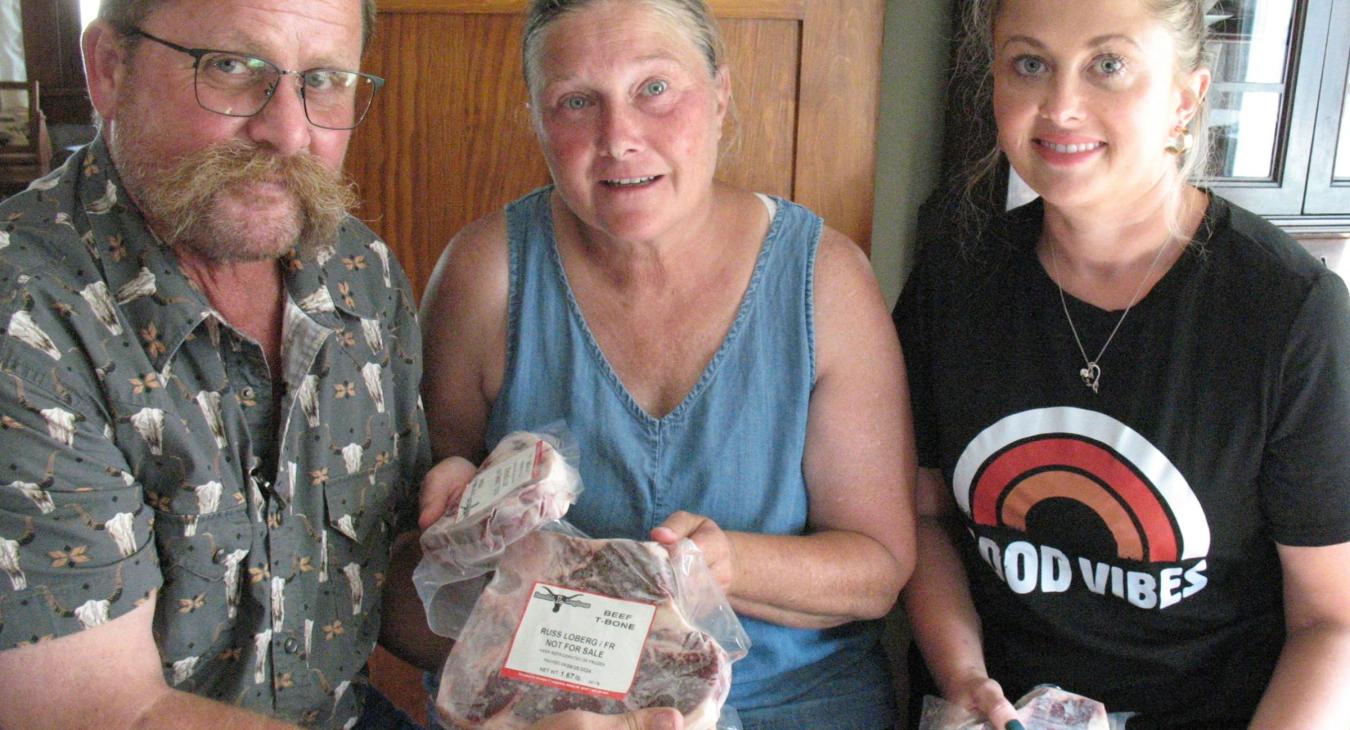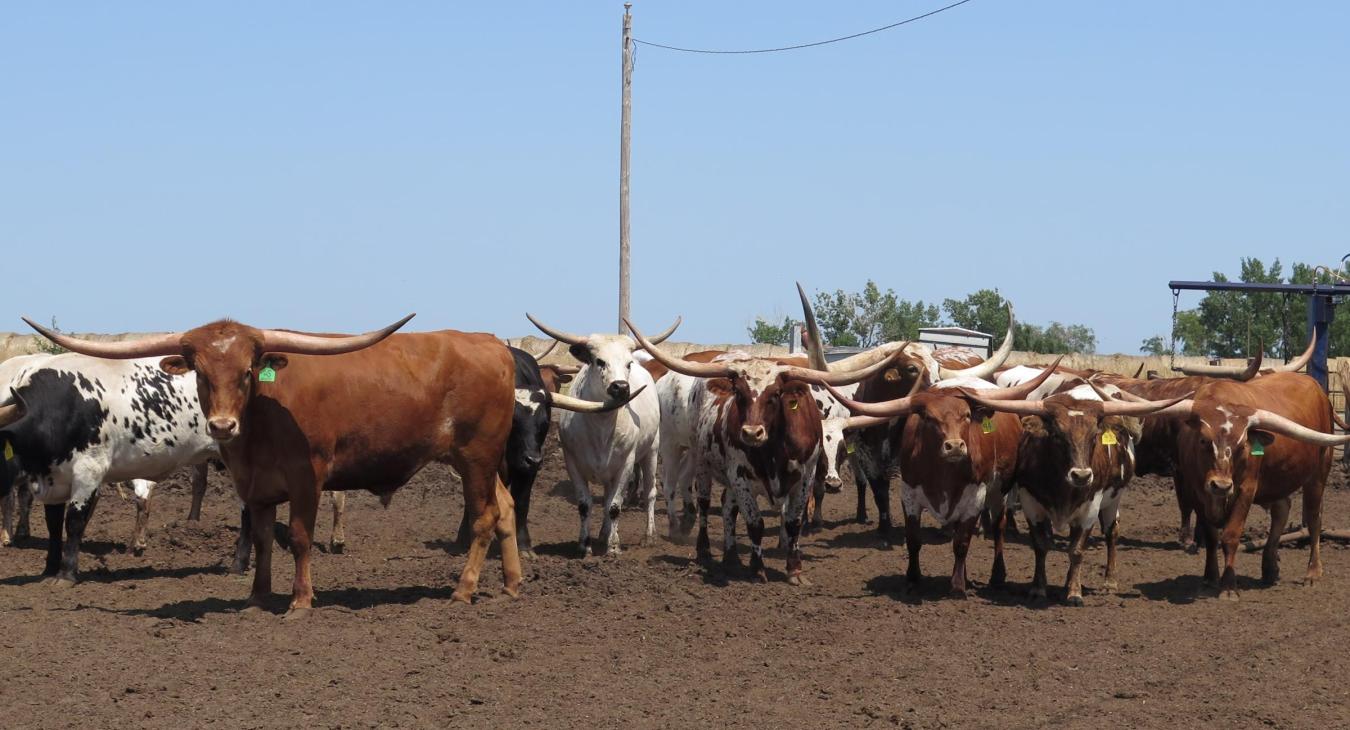By LaRayne Topp
It may be the image of a red-eyed bull pawing the earth and snorting fire while its long horns wave danger. Or the idea of a bucking rodeo bull ridding itself of a determined cowboy. Or the running of the bulls in Spain where mobs of crazed folks stampede down a narrow alley, inches away from stampeding bulls, that lends itself to the idea that Texas Longhorns are mean.
But perhaps true Longhorns are closer to the docile Ferdinand the Bull, from the children’s book, who prefers to loaf around and smell the flowers, gentle, smart, and slightly amorous around cows from the herd.
Russ Loberg of Wisner, Nebraska, appreciates the looks of Longhorn cattle, their horns curving far past the sides of their heads. Some of the first cattle brought to North American by Europeans, the breed is known for its intimidating and sizable horns, which can grow as much as nine to ten feet or longer from one tip to the other, Loberg says. Generally, the horns of bulls are of moderate length, while those of steers may be much longer.
“They’re therapeutic to feed and watch,” Loberg explains. His wife, Janell, agrees. She particularly enjoys watching the calves. “It’s awesome to watch them play in the spring,” she says, a time when they kick up their heels and run, as free as, well, as spring calves.
The Lobergs began raising Texas Longhorns in 2017. He is owner and operator of Russ Loberg Electric, and Janell runs Little Sparks Daycare.
“We were totally blind-folded when we went into this,” Russ explains. However, the couple thought it would be nice to place Longhorn cattle on pastureland they owned along the Elkhorn River, primarily to keep the weeds down. They agreed on purchasing two head. Soon Russ brought another cow home and the two became three. All of a sudden there were six Longhorns grazing in their pasture.
“Like I wouldn’t notice,” Janell says.
Since then, that number has multiplied to a herd of more than 100 heifers and steers, cows and bulls, introducing different blood lines along the way.
Soon, Branded L Longhorns was born, a business managed by the Lobergs and their daughter Amber. Heifers were bred, and the bull calves were transformed into steers to finish out for market. They are fed grass the first few years, then grain-finished on a mix of brome and alfalfa hay, silage and corn. Consequently, it can take three to three and a half years to finish a steer to an average of 1,200 pounds without the use of drugs and hormones.
“It tastes like the meat we grew up on,” Janell explains. The couple uses no growth hormones as they believe fattening a critter fast affects its flavor. “When you hurry something up, you lose something else, which is taste.”
Longhorn beef is leaner than other types of beef with just the right amount of marbling, according to the Lobergs, which makes if healthier and lower in calories. Even so, it is flavorful and tender. In addition, Branded L Longhorns are raised humanely. Their lives are lived in virtual comfort. When they are relocated from a winter pen to summer pasture, loading into stock trailers is completed without the use of cattle buzzers, a piece of equipment the Lobergs don’t even own. Russ believes that reducing stress and raising cattle humanely is reflected in the taste of the meat.
The cattle are kept from roaming away by electric fences with electricity provided by the Stanton County PPD and Cuming County PPD.
The Loberg Longhorns are not run through cattle chutes numerous times for a variety of hormone shots, an activity that “jacks them up,” Russ says. Instead, they’re treated only once a year, for lice and to measure the width of their horns.
The Lobergs are cautious around newborn calves and their mothers for about three days following calving. Mothers are understandably protective at that time. In addition, Russ and Janell are careful around the animals in case one of them swings a head with horns of such width.
The couple’s lean and drug-free meat is marketed in a variety of ways: it is sold locally in the Wisner area at eating establishments, grocery stores and quick shops as well as through Elsworth Crossings in Omaha.
“I’m always on the lookout for restaurants who’d like our pre-patted burgers to grill and serve,” Russ says.
The various cuts the Lobergs have developed include a wide variety of steaks and roasts, ground beef and a number of dried beef and sausages. Their biggest sellers are beef jerky and beef sticks. Or the customer can purchase a whole critter or a half on the hoof and have it custom-butchered at a locker of their choice along with a fee for hauling.
The Texas Longhorn had its origins from a breed of cattle brought to the Americas by Spanish conquistadores during the time of the second voyage of Christopher Columbus in 1493. They were brought in to feed the colonists on the Caribbean island now known as Hispaniola, often referred to as Santo Domingo. The cattle were found to have a higher tolerance of heat and drought than other European breeds.
For the next two centuries, the Spaniards used the cattle in Mexico, gradually relocating them north into the land which eventually became known as Texas. Some of the critters escaped and the breed became a feral animal, roaming the open range. Descendants of these cattle came to develop a high drought tolerance and other hardy characteristics. The animals slowly dwindled, but in 1927, the breed was saved from extinction by the efforts of the U.S. Forest Service who bred a small herd on the Wichita Mountains Wildlife Refuge in Lawton, Oklahoma.
At first the animals were raised as a curiosity, but eventually the breed proved their value as beef stock, considering the Longhorns’ longevity, resistance to disease, and ability to thrive on marginal pastures.
The coat color of a Texas Longhorn is variable with 40 percent some shade of red. They can also be a variation of black, blue, brown, cream, dun, grey, yellow or white, with or without speckling, spotting or brindling, which is a type of tiger stripe. The cattle can also feature a finching pattern: a white or pale stripe along the spine. When the critter’s base coat color is black, this feature is called zorillo from the Spanish word for skunk.
No matter the coloring, the Lobergs not only enjoy the looks of their animals but also the quality of the meat.
“I’m not going to change the world growing longhorn cattle,” Russ said, “but drug-free cattle is our choice and our customers’ choice.”
To learn more about Branded L Longhorn beef, contact Russ Loberg at (402) 380-2484 or Amber Loberg at (402) 380-4682.


